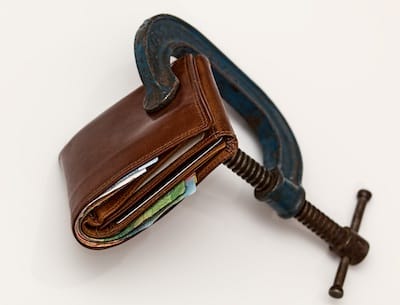
As financially-focused parents, we want to ensure that our kids learn the value of money. Our twins recently turned five years old and the topic of allowances is back on my mind. Rather than try to invent everything from scratch, I reached out to the experts on the Rockstar Finance Forums to see how others have made things work in their families.
This post summarizes the major elements and considerations in giving kids an allowance Using experiences from a variety of personal finance bloggers, you should be able to assess your options and structure an allowance system that works for your family. You’ll even hear a bit about how my parents structured my allowance when I was a kid.
Why Give Kids an Allowance?
We have a lot of goals we’d like to accomplish in setting up an allowance system with our kids:
- To teach our kids the value of hard work
- To teach our kids how to manage their money (budgeting, saving responsibly)
- To reinforce our values (charitable giving, sustainable living)
- To get some help getting things done around the house!
That last one may sound a bit silly, but it’s true; with two 5-year-olds and a 6-year-old, even a minimalist household can get messy pretty quickly. Those same little hands that pulled out all the toys are capable of putting them back.
After reading The MoneySmart Family System last year, I was inspired to see how the Economides family accomplished many of the same goals that we had. In trying to implement it, however, we found that the system was challenging to stick with for our kids at their current age.
With that in mind, let’s see how some great personal finance minds approach this with their kids and see if we can piece together a strategy for the Keep Thrifty family.
When and How Kids Earn Allowances

The first big question to tackle here - should allowances be earned or a given?
Jim from Route to Retire goes with a pure earning mentality - he pays his 5-year-old daughter $0.50 a week for taking out the trash; it’s a great way to teach her the value of hard work.
Tom from High Income Parents has two requirements for his kids’ allowances - they have to remember to ask for their allowance on Friday or Saturday and they have to keep up with their common chores around the house (keeping their room clean, etc.). This is a great way to teach kids to be their own advocates and maintain responsibility in the house.
Laura from Savvy Family Finance gives a fixed weekly allowance without a direct tie to chores. This approach can help reinforce the concept that pitching in is a part of being in a family.
Melanie from Mindfully Spent uses a hybrid approach with her son - he earns $10 every two weeks with a base level of chores is expected. Optionally, her son can do an additional chore to add another $10 to each pay period.
There’s value to each approach here - each emphasizes a different lesson or value that the parents wanted to see reflected in their family. There’s no wrong answer here - it all depends on what your goals are.
So, once you’ve decided how to give your kids an allowance, the next big question is how much?
How Much Allowance Should Your Kids Get?

It’s important that the amount of allowance is meaningful. Giving a teenager $0.10 for mowing the lawn isn’t likely to get the grass cut.
That’s one reason age-based allowances are popular. Money Beagle thinks $1/week for each year of age is a good way to scale up while over time without breaking the bank. This is also a good way to help older kids feel like the allowance system is fairer - they are capable of doing more and get compensated accordingly.
Liz from Chief Mom Officer pays her 13-year-old and 9-year-old the same - $2/week - and gives them the option to earn more with extra chores if they are feeling ambitious.
Slow Dad of Cantankerous Life pays based on how gruesome the chore is. Vacuuming will get you a little. If you want to make the big bucks? Go clean the toilets :)
The real secret to the answer of how much lies in the answer to a different question - what is the allowance allocated for?
What Kids’ Allowances Should Be Used For

Jim from Route to Retire makes his daughter responsible for buying most of the things she wants but doesn’t need. This helps teach delayed gratification and smart shopping.
Steve and Annette’s approach in the MoneySmart Family System encourages progressive responsibility over time. Purchasing responsibility for their kids starts with wants (toys, games, entertainment) at a young age, and grows to include needs (car insurance, clothes) to match growing responsibility for their children.
Melanie from Mindfully Spent advocates splitting allowances three ways - saving, spending, and sharing. This is a great way to teach kids about saving early in life and to put their values (like charitable giving) into their budgets.
I’ve seen lots of divisions between Save, Spend, and Share in the past. We did 50%/40%/10% for our kids when we were doing an allowance earlier this year. I really appreciated the approach from High Income Parents. Tom sets a minimum of 20% to Share and a minimum of 40% to Save. After that, it’s up to his kids to decide if they want to keep the rest for spend or put extra into the share or save categories.
Laura from Savvy Family Finance goes a step further by including another category for investing. Savings may cover emergencies or long-term goals, but investing and the power of compounding interest are really important in setting up a strong financial foundation for your kids.
When I was in early middle school, my parents gave me an allowance based on the Envelope Budgeting System. I had a set allowance for each category - some wants (i.e. clothing), some needs (i.e. awesome CDs from the 1990’s), and an envelope for savings as well. There was a fixed amount that went in each week and I wasn’t allowed to shuffle money between envelopes. This helped me to understand how to use budgeting to keep my finances aligned with my goals.
It also painfully highlighted my lack of interest in clothing. At one point my clothing envelope was overflowing with $20 bills to the point that my parents gently encouraged me to finally replace some of my old shirts and pants.
What Age to Start Giving Kids an Allowance

There seems to be a fair amount of consensus amongst the experts on this one - Savvy Family Finance, High Income Parents, and Money Beagle all started allowances around kindergarten age (somewhere between ages 4 and 6). This age seems to strike the sweet spot where kids have enough of an understanding of what money is and how it is used to appreciate an allowance.
If you missed the boat, don’t despair. It’s better to start late than never!
That is, at least, unless the best time to start is actually…never. Amanda from Centsibly Rich hasn’t ever given her kids a set allowance and they are now in their teens. They get a bit of money for gas but all of their non-essential purchases come from money they’ve earned elsewhere or were given on birthdays and holidays.
When to Stop Giving Kids an Allowance

I’ve always appreciated the rule my parents used when it came to our allowances.
Allowances last until you’re old enough to legally work. I pushed the limit on this one a bit, getting my first paid work as a babysitter at age 11 and quickly progressing to learning about life through picking up garbage in parking lots and waxing storage unit doors.
This gave me the opportunity to determine my own financial destiny from a fairly early age - I had to learn how to balance my spending plans with my desire to avoid doing crappy jobs :)
Tom from High Income Parents plans to pay allowances until his kids graduate High School.
Mrs. Need2Save didn’t stop based on an age - she stopped based on assessing what worked best for her family. She tried allowances with her kids but found it had added stress to their lives based on the quality of chores done. Sometimes it is more work to oversee your kids doing chores than doing them yourself!
A Tool to Help Teach Your Kids About Money

We’ve traditionally managed our kids’ allowances using cash but it is clear that money is increasingly being handled digitally and it’s a great idea to include this in how you approach money with your kids.
If you’re looking for an awesome way to teach your kids how to earn and spend money responsibly, I’d recommend you take a look at FamZoo’s Virtual Family Bank. Your kids can earn money from you and use their own debit card to spend what they earn without the risk of overdrafting your account.
Allowances in the Keep Thrifty Household

First, I want to give a BIG thanks to all the experts for providing their insight and experiences. There are a ton of great ideas here so I tried to mix and match in a way that best meets our goals with an allowance system.
Here’s what that looks like:
- A base level of chores is assumed with no allowance given (cleaning room, bringing dirty dishes to counter, etc.). This base level will grow as the kids get older and are capable of doing more around the house.
- Money can be earned by requesting additional chores with pre-set values. Additional chores are not available for kids that have not finished their base level of chores
- If we want to get fancy, we could even use these awesome custom chore magnets.
- Money earned from chore allowances should be divided into four categories - give, invest, save, and spend. A minimum of 10% will be put into give, a minimum of 30% into invest, and a maximum of 20% into spend.
- Hopefully, this encourages the kids to focus on investing for their future, giving back, and minimizing impulse purchases (while still having some fun). Save funds will be targeted toward bigger-ticket items that’ll take time to get.
- Invested money will earn a compounded rate (amount TBD) provided by the bank of Dad :)
- When the kids are a little older (currently they are 6, 5, and 5), a fixed allowance will start that covers some base necessities (clothes seem like a good place to start).
- Once the kids are able to legally work, chore allowances will go away but fixed allowances will remain until high school graduation.
With the help of the experts, I think this structure would work really well for our family!
There are a lot of considerations in how to structure allowances for your kids. The key is to remember that every family is different and whatever you choose needs to align with the goals you have in raising your kids.
How do you structure allowances for your family? If you don’t have kids or aren’t doing any allowances yet, how did your parents structure this for you when you were a kid?
